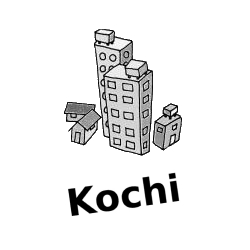Executive Summary
| Disclaimer: Links within the texts to additional information, concepts and tools are SSWM editor’s inputs and might not represent the view or practices of GIZ. |
Introduction to Kochi
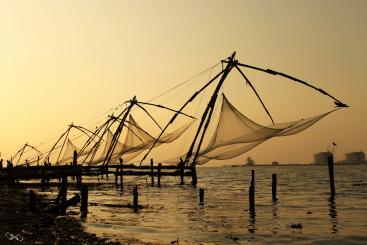
Chinese fishing nets of Kochi. Source: ZEROXZERO (2011)
Often hailed as the queen of Arabian sea, Kochi is the commercial capital of the beautiful southern state of Kerala. The city is located at the Malabar Coast of India. Due to the proximity to the Arabian Sea, Western Ghats and lagoons of Alappuzha, the city of Kochi has been a prime location for commerce and defence in South Asia since ages. The port of Kochi is the closest one in India to the international shipping routes. Due to this strategic location and the high reputation of Kerala as an international tourist destination, Kochi has grown as one of India’s most visited cities (KOC n.y.).
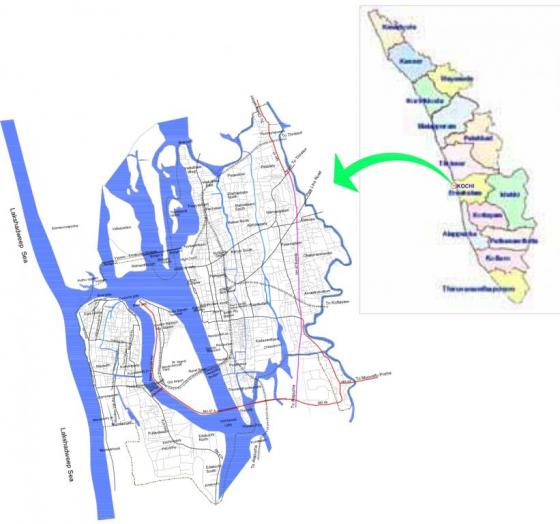
Location of Kochi. Source: KMC et al. (2011)
The area under Greater Kochi Development Authority (GCDA) encompasses KOC, six municipalities and 25 panchayats covering an area of 632 km2. This area accounts for a population of 2.1 million out of which 30-35% are below poverty line. More than half of this poor reside in the 283 slums in the KOC area.
Kochi at a Glance
Population | 2.1 million (GCDA) 0.6 million (KOC) |
Total area of urban agglomeration | 632 km2 |
Area covered in CSP | 95 km2 (KOC) |
Number of wards | 74 |
Under the National Urban Sanitation Policy (NUSP) a city sanitation exercise was initiated based on 19 sanitation indicators (output, process and outcome indicators). The cities where then categorised under a 4 colour coding system based on the scores. Kochi secured an overall score of 41.07 out of 100 and falls under the "black" category. The city ranked 81st among 423 cities where the exercise was carried out (see also National Award Scheme for Sanitation for Indian Cities).
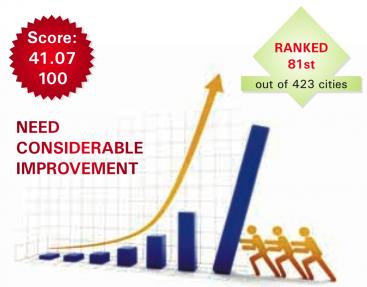
NUSP Sanitation Ranking for Kochi. Source: KMC et al. (2011)
The City Sanitation Plan (CSP) of Kochi has been prepared for the area under the KOC which constitutes a population of 0.6 million (see also City Sanitation Plans according to the NUSP). The CSP was prepared in three phases: 1) diagnostic phase, 2) consultation/ analysis phase and 3) finalisation of outputs. The first phase initiated the process by interactions with governing bodies and setting up of the City Task Force (see also formation of City Task Force). In the second phase, a baseline study of the area was carried out by surveying a representative sample of 500 households across 71 wards along with 20 commercial and institutional establishments, 10 public locations and 70 out of 283 slums (see also preparation of Status Report). The third phase focussed on understanding the key issues and identifying technological and financial solutions along with ward level pilots for components for behavioural change (see also preparation of Action Plans). The CSP has brought up 9 key issues, which are partly described below (KMC et al. 2011).
Key Issues Identified
(Adapted from KMC et al. 2011)
Access to Toilets
Even though 95.5% of city population has individual toilet access, 2% resort to open defecation. It is interesting to note that 19% of the urban poor don’t have individual toilets and the toilet facilities of the slums were found to be inadequate. Public toilet facilities for migrant labourers are also inadequate.
The CSP recommends the immediate implementation of inspection and maintenance of the existing toilets and as a long-term measure, the development of City-wide Toilet Development Plan with dedicated budget and time bound delivery (see also access to water and sanitation).
Water Supply
The water supply is often low and unreliable and hence the households frequently rely on private tankers (see also water vendors). Though 100% of household connections are metered, 40% of the meters are faulty, making the cost recovery of water supply services inadequate.
The recommendations of CSP are directed towards 100% operation and maintenance (O&M) cost recovery by proper tracking and reporting the costs of service, bulk metering at intake, treatment, storage and pumping points and periodic maintenance of meters at individual connections. See also water pricing in general, water sources, water purification and water distribution.
Drainage Network
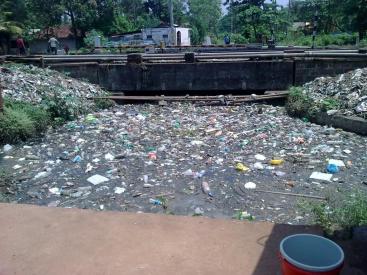
Solid Waste dumping in Mullissery Canal. Source: I. Raj (2011)
Less than 5% of the city has sewerage network. The proposed projects in the city can bring this close to 25% area, but the high groundwater tables, sub-surface geology and a unique topography adversely affects the technical feasibility of extension of the sewer lines. Narrow street widths also add to the issues in expansion. Waste dumping and sullage flows in the canal and drains are adding on to the ineffectiveness of the drains and are making them vulnerable pollution hotspots. The drainage network coverage is about 41% relative to the road networks and the drains are absent in many areas with urban proliferation. Lack of a city-wide drainage and canal master plan, lack of integration and inadequate focus on design requirements further limit the functioning of the cities drain network (see also open channels and drains).
The CSP recommends a comprehensive review of Detailed Project Reports (DPRs) for conventional sewerage systems along with an awareness and stakeholder engagement initiative to understand the local concerns (see also conventional sewers, awareness raising in wastewater treatment and stakeholder analysis). It is also recommended that the KOC and Kerala Water Authority (KWA) should revise the Sewerage Master Plan for implementing wastewater management and study the feasibility of hybrid wastewater management for separate management of greywater and blackwater (see also sanitation systems and separate sewers). A master plan for drainage is also required to be made, understanding the primary and secondary drainage, developing a run off management strategy and network zoning and phasing for implementation.
Wastewater Management
Due to lack of sewer systems, wastewater treated is dependent on septic tanks. The septage clearance is through private providers and is not regulated through any means. The septage is illegally done in water bodies or vacant plots without considering the environmental consequences. Kerala State Pollution Control Board (KSPCB) has no information base on septic tanks or pit latrine systems in use in the city.
It is recommended that the KOC and KWA should study and implement facilities to receive and treat septage. Laws on septage management should be laid down along with adequate capacity building for private service providers and it should be ensured that safety, health and environment practices in septage management are followed. See also onsite storage and treatments, semi centralised wastewater treatments, invalid link, invalid link, invalid link, invalid link and environmental issues.
Solid Waste Management
Even though Kochi has seen significant improvement in door-to-door collection efforts through the Kudumbashree agencies, the cost recovery is limited as the user charges are retained within the collection agencies. The challenges with respect to littering and in waste recovery/ safe disposal are also persistent.
The CSP recommendations focus on strengthening of the door-to-door collection and source segregation measures along with the initiation of a feasibility study for improving waste processing/ landfill facilities. See also the chapter solid waste.
Governance Issues
The major constrain in the long-term planning and governance of the urban agglomeration of Kochi is the power division among multiple agencies. Governance over the area is done by KOC, Urban Local Bodies (ULB) and other agencies in different parts of the urban area bit the responsibilities for implementation of large capital projects, city level master planning, etc. with respect to water and sanitation lies within the hands of organisations such as KWA and GCDA. Within the KOC the responsibility for sanitation is diffused across multiple departments, while solid waste management (SWM) is being handled by the Health Department, procurement of vehicles is handled by Engineering section. Officials are also constrained by inadequate exposure to modern practices in water supply, sanitation and solid waste management, which has affected effective delivery of projects.
Along with the formulation of a State Sanitation Strategy, which should be in line with the NUSP guidelines and CSPs in the state, the KOC is recommended to form a Coordination committee to jointly coordinate in planning and delivery. The ULBs require support from the Government of Kerala (GoK) through model bylaws, manuals and regulations in various subjects related to water and sanitation in order to strengthen the policy frameworks. It is also recommended that KOC centralises all its sanitation activities under a Sanitation Department and its accounts related activities under a Finance department. Strengthening of the operating staff is also required for effective complaint resolution. See also the chapter creating an enabling environment in wastewater treatment, especially invalid link, invalid link.
Financial Sustainability
Non-availability of information on costs of KWA is a major constrain in financial analysis. The collection efficiency and cost recovery is close to 50% only and KWA continues to incur losses due to very high non-revenue water. Cost recovery data on solid waste management is also not reported. A normative estimate on the capital required for the next 5 years was prepared during the CSP preparation.
KOC is recommended to rationalise user charges (see water charges), improve collection efficiency and ensure 100% O&M cost recovery. The CSP looks upon KWA to maintain cost and revenue information in the KOC level to make it easier to rationalise tariffs and improve water and sewerage connections. See also financial sustainability of WASH services.
Selected Interventions
After the preparation of the CSP, GIZ has initiated three major interventions till date. These activities are focussed on improving the knowledge base and supporting the planning process for further actions. These interventions are primarily based on the slum areas of Kochi and are described below.
Preparation of Pollution Discharge Register at Rameshwaram-Kalvathy Canal
(Adapted from GIZ 2012, Preparation of Pollution Discharge Register)
The Rameshwaram-Kalvathy Canal is 5 km long, flows through Fort Kochi area and has impacts on many adjoining wards at Fort Kochi area. The intervention at Rameshwaram-Kalvathy Canal focuses on the key issue of septage management and the corresponding water pollution (see also septic tanks). The CSP recommendation of preparation of an inventory related to wastewater discharge is being addressed here through a comprehensive survey. The survey focuses on the various points including (i) discharge characteristics of the households, (ii) type of contributors, (iii) conditional assessment of the sanitation infrastructure in households, (iv) water quality assessment of water bodies such as canals, (v) estimation of pollution load, and (vi) creation of sanitation database in form of Management Information Systems (MIS) in a GIS platform. The pollution register will be prepared from the survey analysis, field assessment, and quality & quantity analysis of the wastewater (see also exploring tools).
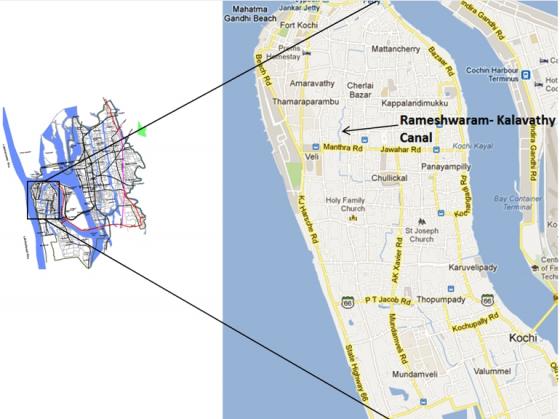
Location of Rameshwaram-Kalavathy Canal. Collage from GIZ (2011) and GOOGLE (2012)
Pilot Initiatives at Rameshwaram-Kalvathy Canal at Kochi
(Adapted from GIZ 2012, Pilot Initiatives)
Further to the pollution register, pilot scale interventions are planned in three slums under Rajiv Awas Yojana (RAY) programme, namely: Thuruthy Colony, Beach Colony and Udaya Colony. The efforts are planned to demonstrate the effectiveness of sanitary interventions. A comprehensive survey on the sanitation facilities is being done along with the field reconnaissance survey to understand the existing scenario. GIZ will be taking a consultative approach with key officials of KOC, people’s representatives and the Corporation’s RAY consultant for technology decisions. The approach will be towards incorporating a combination of centralised and decentralised sanitation systems, generating alternate fuel sources and promoting recycling and reuse of treated wastewater (see also sanitation systems, on site storage and treatments, semi centralised treatments, reuse and recharge). Depending on the results of the pilot study in these three slums, the approach may be scaled up for city level planning.
Implementation of Household Sanitation System in Slum Areas at Kochi
(Adapted from GIZ 2012, Implementation of Household Sanitation System)
This effort is aimed at improving the on-site wastewater management (see on site storage and treatments) by distributing pre-fabricated septic tanks to the slum colonies, thus reducing the pollution load in the canals and backwaters (see also open channels and drains). The existing conditions of the sanitation infrastructure are being assessed by a comprehensive survey that will be integrated to a sanitation database with GIS interface. The survey is focused on assessing the condition of wastewater disposal in the households, status of the land tenure, availability of space for installation of septic tanks and soak pits, willingness of the beneficiary to install septic tanks and to bear the expenses related to installation.
Following the survey, 300 pre-fabricated High Density Polyethylene Septic tanks (HDPE) will be installed on a pilot basis in selected households in ward 26. The list of beneficiaries will be approved by the KOC and the assessment of the existing conditions prior to the installations, household survey, monitoring during the implementation will be done by agencies appointed by GIZ. An undertaking from the beneficiary that the septic tank and soak pit will be installed within two weeks of the receipt of the septic tanks will be made in order to ensure the timely actions from the beneficiaries. Moreover, performance appraisal, impact monitoring (including water quality assessment), and training and awareness building activities will be taken up as follow up measures (see also ensuring sustainability, follow-up of projects, using indicators to measure progress and performance, awareness raising and invalid link).
Draft City Sanitation Plan for Kochi
GIZ is supporting various cities in the preparation of City Sanitation Plans (CSPs) under the National Urban Sanitation Policy (NUSP) formulated by the Ministry of Urban Development (MoUD), Government of India (GOI) in 2008. This summary contains city level key issues for Kochi.
GIZ (2011): Draft City Sanitation Plan for Kochi. Executive Summary. New Delhi: Municipal Corporation of Kochi in cooperation with GIZ and ImaCS URL [Accessed: 31.10.2012]Preparation of Pollution Discharge Register at Rameshwaram-Kalvathy Canal
After the preparation of the City Sanitation Plan (CSP) of Kochi, India, GIZ has initiated this intervention among others. The development of Slums has emerged as one of the key intervention to be addressed to bring about overall improvement in the sanitation profile of the city.
GIZ (2012): Preparation of Pollution Discharge Register at Rameshwaram-Kalvathy Canal. Eschborn: Gesellschaft fuer Internationale Zusammenarbeit (GIZ)Pilot Initiatives at Rameshwaram-Kalvathy Canal at Kochi
After the preparation of the City Sanitation Plan (CSP) of Kochi, India, GIZ has initiated this intervention among others. The recommendation of the CSP was to make an inventory of waste water discharge from the households, its effect on water bodies, create a baseline data comprising mapping of nonpoint sources of pollution, water quality assessment, etc., and to implement intermediate measure such as household sanitation systems.
GIZ (2012): Pilot Initiatives at Rameshwaram-Kalvathy Canal at Kochi. Eschborn: Gesellschaft fuer Internationale Zusammenarbeit (GIZ)Implementation of Household Sanitation System in Slum Areas at Kochi
After the preparation of the City Sanitation Plan (CSP) of Kochi, India, GIZ has initiated this intervention among others. The recommendation of the CSP was to make an inventory of waste water discharge from the households and to implement intermediate measure such as household sanitation systems.
GIZ (2012): Implementation of Household Sanitation System in Slum Areas at Kochi. Eschborn: Gesellschaft fuer Internationale Zusammenarbeit (GIZ)City Sanitation Plan for Kochi
This Brochure is a succinct overview of the City Sanitation Plan for City of Nashik in order to recognise the stress areas in the sanitation sector and establish priorities in the intervention areas along the defined strategic guidelines.
KMC GIZ IMACS (2011): City Sanitation Plan for Kochi. New Delhi: Municipal Corporation Nashik in cooperation with GIZ and ICRA Management Consulting Services Limited (IMaCS) URL [Accessed: 05.11.2012]City Sanitation Plan for Kochi
This Brochure is a succinct overview of the City Sanitation Plan for City of Nashik in order to recognise the stress areas in the sanitation sector and establish priorities in the intervention areas along the defined strategic guidelines.
KMC GIZ IMACS (2011): City Sanitation Plan for Kochi. New Delhi: Municipal Corporation Nashik in cooperation with GIZ and ICRA Management Consulting Services Limited (IMaCS) URL [Accessed: 05.11.2012]Draft City Sanitation Plan for Kochi
GIZ is supporting various cities in the preparation of City Sanitation Plans (CSPs) under the National Urban Sanitation Policy (NUSP) formulated by the Ministry of Urban Development (MoUD), Government of India (GOI) in 2008. This summary contains city level key issues for Kochi.
GIZ (2011): Draft City Sanitation Plan for Kochi. Executive Summary. New Delhi: Municipal Corporation of Kochi in cooperation with GIZ and ImaCS URL [Accessed: 31.10.2012]Preparation of Pollution Discharge Register at Rameshwaram-Kalvathy Canal
After the preparation of the City Sanitation Plan (CSP) of Kochi, India, GIZ has initiated this intervention among others. The development of Slums has emerged as one of the key intervention to be addressed to bring about overall improvement in the sanitation profile of the city.
GIZ (2012): Preparation of Pollution Discharge Register at Rameshwaram-Kalvathy Canal. Eschborn: Gesellschaft fuer Internationale Zusammenarbeit (GIZ)Pilot Initiatives at Rameshwaram-Kalvathy Canal at Kochi
After the preparation of the City Sanitation Plan (CSP) of Kochi, India, GIZ has initiated this intervention among others. The recommendation of the CSP was to make an inventory of waste water discharge from the households, its effect on water bodies, create a baseline data comprising mapping of nonpoint sources of pollution, water quality assessment, etc., and to implement intermediate measure such as household sanitation systems.
GIZ (2012): Pilot Initiatives at Rameshwaram-Kalvathy Canal at Kochi. Eschborn: Gesellschaft fuer Internationale Zusammenarbeit (GIZ)Implementation of Household Sanitation System in Slum Areas at Kochi
After the preparation of the City Sanitation Plan (CSP) of Kochi, India, GIZ has initiated this intervention among others. The recommendation of the CSP was to make an inventory of waste water discharge from the households and to implement intermediate measure such as household sanitation systems.
GIZ (2012): Implementation of Household Sanitation System in Slum Areas at Kochi. Eschborn: Gesellschaft fuer Internationale Zusammenarbeit (GIZ)http://www.corporationofcochin.net/
This is the official website of the Corporation of Kochi, Kerala, India.

